July 18 , 2010 – 11:48 pm EDT
What an interesting week! We were on the verge of a trend change but the small caps didn’t come to the party and the market sold off heavily on Friday. I posted to our Facebook page on Thursday “QQQQ, IYT and SPY all say trend change but IWM says not yet!” Unfortunately only a handful of you follow us on Facebook… are we no fun or do you just not use FB? It is a great way to share mid week updates and discuss interesting topics – Find our page here.
****Thanks to all those who referred people to this newsletter over the last week, sharing is caring.
.
ETF % Change Comparison
.

Now look at this… SMH managed to advance 0.55% for the week and is up almost 7% over the last two weeks. If the market was really sick then I would expect to see SMH being slammed. What is concerning though is how poorly the small caps in IWM are performing; they are down from their peak almost twice as much as SMH. We are unlikely to see a strong trend while these conflicting internals continue.
.
What the % Comparison Table Tells Us:
By comparing the performance of the economically sensitive (SMH, QQQQ, IWM, IYT) and the comparatively stable ETFs (SPY and DIA) we can get an indication of the true market direction. The more sensitive areas of the market tend to be the first to initiate a trend change. For example if DIA and SPY sell off heavily while SMH and IWM (Russell 2000 small cap ETF) sell of mildly or continue moving to new highs then this would be very positive and vice versa.
The ‘Average Rank %’ is calculated by subtracting the % change for each ETF from the maximum % change and dividing it by the range for each period. 1-((MAX(% change all ETFs)-ETFs % Change)/(MAX(% change all ETFs)-MIN(% change all ETFs))) The readings for each period are then averaged. This reading is provided because if one ETF was significantly under/out performing the others then a plain high or low rank would not accurately reflect this.
.
![]()
.
A Look at the Charts
.
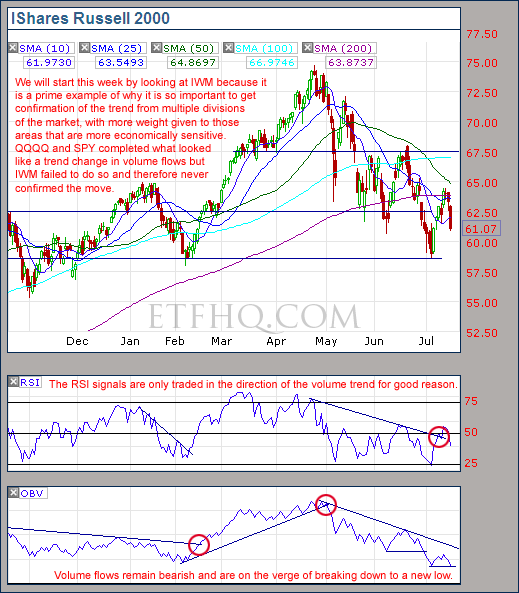
Here you can see the failure of IWM to confirm the trend change by QQQQ and SPY. Money is leaving the small caps with real enthusiasm.
.
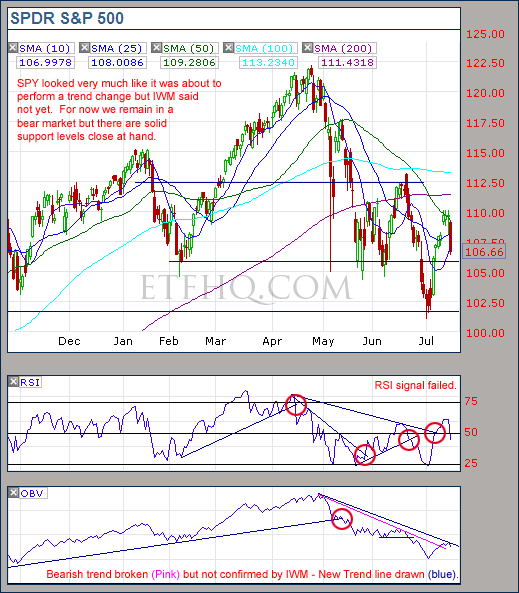
To look to only one area of the market is like seeing the world in only one color: A huge amount of detail is lost.
.
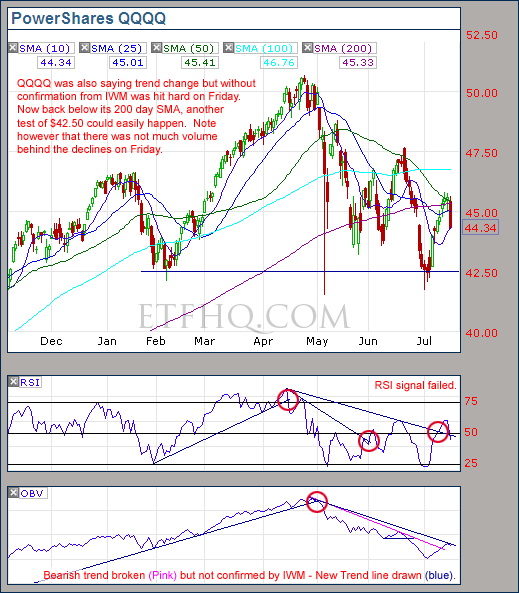
Volume behind the declines on Friday was nothing impressive and there is powerful support at $42.50. IWM and SMH will need to sell off heavily if QQQQ is to fail at support.
.
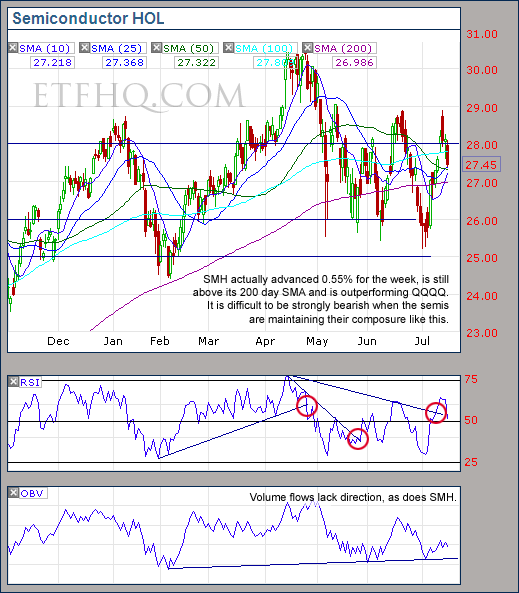
Looking at SMH gives me confidence in the prospects for this market. It would not be holding together so well if the bear market was really strong.
.
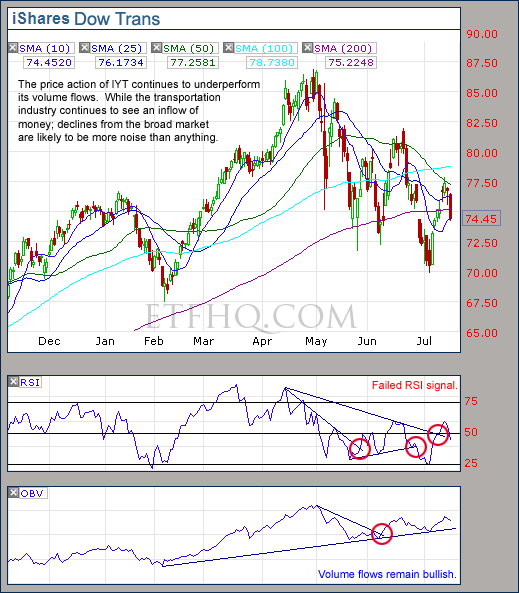
Volume flows for IYT continue to maintain their bullish trend – another reason to believe that the sky is not falling.
.
![]()
.
OM3 Weekly Indicator
.

‘Stong Sell’ signals indicate that the trend is still down while the ‘Bull Alerts’ indicate that the weekly cycle continues to turn up.
.
How to read the OM3 indicator
The OM3 indicator as with most of our models primarily reads price action and volume. The strong/weak buy/sell signals are self-explanatory. ‘No Signal’ means that the component readings are in conflict and cancel each other out.
The alerts let you know if the cycle is speeding up or slowing down, so when you get at ‘Strong Buy, Bear Alert’ for instance it simply means that the criteria for a strong buy is in place but this weeks cycle reading is weaker (or more bearish) than last weeks reading (the same is true in reverse).
The number of weeks that a signal has been repeated is displayed. Historically a ‘Strong Buy’ signal has lasted for an average of 6 weeks and a maximum of 42 weeks, while a ‘Strong Sell’ has lasted for an average of 4 weeks and a maximum of 16.
This is an indicator not a mechanical trading model. It is useful to assist in analyzing the market but for the best results should be combined with commonsense and support/resistance levels etc.
.
![]()
.
TransDow & NasDow
.

For the NasDow there continues to be no clearly dominant index while for the TransDow the Dow remains dominant. Historically the market has been very unproductive under these conditions and has seen the majority of it’s major declines.
.
What the TransDow Readings tell us:
The TransDow measures dominance between the DJ Transportation Index (DJTI) and the Dow Jones Industrial Average (DJIA). In a strong market the more economically sensitive Transportation Index should be dominant over the DJIA.
Historically the DJTI has been dominant over the Dow 45% of the time. The annualized rate of return from the DJTI during this period was 18.47% with the biggest loss for one trade sitting at -13.27%. The annualized return from the DJIA during the periods it was dominant over the DJTI was just 4.06% and the biggest loss for one trade was -16.13%. A 4% stop-loss is applied to all trades adjusting positions only at the end of the week.
What the NasDow Readings tell us:
The NasDow measures dominance between the NASDAQ and the DJIA. Using the same theory behind the Trans Dow; in a strong market the more economically sensitive NASDAQ should be dominant over the DJIA.
Historically the NASDAQ has been dominant over the DJIA 44% of the time. Taking only the trades when the NASDAQ is above its 40 week moving average the annualized rate of return was 25.47% with the biggest loss for one trade sitting at –8.59%. The annualized rate on the DJIA during the periods it was dominant over the NASDAQ is just 8.88% and the biggest loss for one trade was –12.28%. A 8% stop-loss is applied to all trades adjusting positions only at the end of the week.
.
![]()
.
LTMF 80 & Liquid Q
.

Both LTMF 80 and Liquid Q remain in cash.
.
Historical Stats:
.

.
How The LTMF 80 Works
LTMF stands for Long Term Market Forecaster. It reads volume flows relative to price action and looks for out performance of volume measured on a percentage basis over the prior 12 months. During a sustained rally the readings will reach high levels (near 100%) making it imposable for the volume reading to always outperform price so any reading above 80% will maintain the buy signal. This system has outperformed the market over the last 10 years but performance has been damaged by some nasty losses. It only produces buy signals and only for QQQQ.
How Liquid Q Works
Liquid Q completely ignores price action and instead measures the relative flow of money between a selection of economically sensitive and comparatively stable ares of the market. It looks for times when the smart money is confident and and can be seen by through volume investing heavily is more risky areas due to an expectation of expansion. This system has outperformed the market over the last 10 years and remained in cash through most of the major declines. It only produces buy signals and only for QQQQ. We will provide more performance details on the web site for these systems soon.
.
![]()
.
Summary
.
We remain in a bear market that is likely to have a weak trend while IYT continues to have bullish volume flows. Expect continued volatility and indecisiveness from the market. This is a challenging period that puts a traders patience to the test. Remember: the stock market is a mechanism designed to transfer money from the active to the patient.
.
Any disputes, questions, queries, comments or theories are most welcome in the comments section below.
.
Derry
And the Team @ ETF HQ
“Equipping you to win on Wall St so that you can reach your financial goals.”
.
P.S Like ETFHQ on Facebook – HERE
.
![]()
.
Riddle of the Day:
Q – How many legs does a dog have if you call his tail a leg?
A – Four, because calling a tail a leg does not make it a leg.